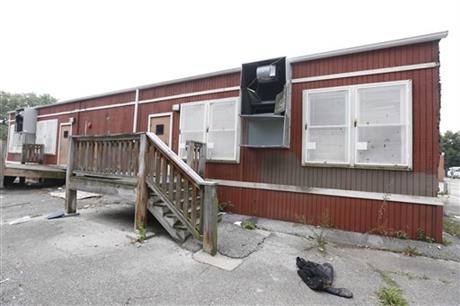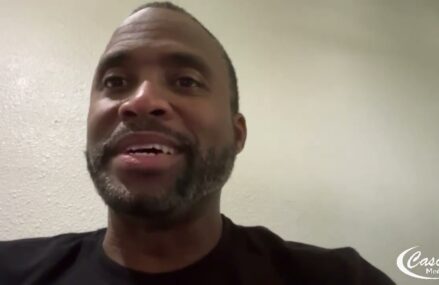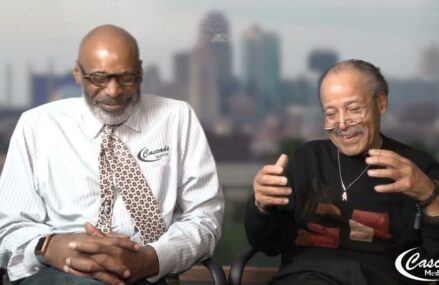
By DON BABWIN
In this Aug. 6, 2013 photo, satellite classrooms at the vacant Guggenheim Elementary School building show disrepair and vandalism in Chicago. In the year since Guggenheim School closed, vandals have descended on the vacant building stripping satellite classrooms of their air conditioning units and causing other damage. It wasn’t long before the playground, so popular with neighborhood kids, was a place to be avoided. (AP Photo/M. Spencer Green)
CHICAGO (AP) — To Carolyn Lang, West Pullman Elementary is more than the school across the street her children attended a quarter-century ago.
It’s where she turned for help when the lock on her front door froze and where school workers watch from their windows to make sure she doesn’t fall victim to crime in an impoverished corner of the city wracked by violence, including two men found shot to death in a car just days ago.
But no more. West Pullman is one of nearly 50 Chicago schools the city closed last spring as part of aggressive cost cutting that calls for the single largest closing of schools in any American city in years.
Critics of the closures have protested that children will be forced to cross gang boundaries to get to new schools. Largely overlooked are the worries of thousands of people like Lang who have relied on the schools to help safeguard poor neighborhoods. Soon, many of those buildings will go as dark and quiet as the boarded-up houses that dot their struggling communities.
“I used to come home late from prayer meetings at my church, and just seeing the light on and knowing the engineers and the janitors were working, I felt safe because they were there,” said Lang, 58. “Now it won’t be a safe haven anymore.”
What will happen to Pullman and other schools is unclear. In recent years, most of the relatively few schools that have closed have reopened as charter, magnet, military, alternative or other kinds of schools.
Chicago schools spokeswoman Becky Carroll said the district is “serious about making sure these buildings have a useful purpose, whether they are sold to a private entity (or used as) some kind of community center.”
But the district has never had to find new uses for so many vacant schools at once. Carroll seemed to acknowledge the challenge in an email, saying no one should expect the buildings to be repurposed “in time for the school year or over the next year.”
For Terry Donaldson, that means a year or two without the security of the West Pullman school.
“I got to know the janitor over there, and he would be cutting the grass and we’d talk, and then he’d watch my back and I’d watch his back,” said Donaldson, 65. “Nobody bothered him or me because they know we watched each other.”
Richard Ingram, who manages rental properties on the South Side, says some tenants call schools rather than police to report crimes to prevent criminals from discovering who they are.
“They’re afraid for their lives, but they know the schools can call and there won’t be any repercussions,” he said.
Nobody is saying that the closed schools will cause the neighborhoods to decline. That has been happening for years. But the concern is that the sight of shuttered schools will accelerate that decline.
“It is a signal that resources are leaving the community,” said Deborah Moore, director of neighborhood strategy at Neighborhood Housing Services of Chicago, a not-for-profit organization that helps people buy homes and keep them out of foreclosure. “There is no way I can market the community to young families. They aren’t going to move into a community with a closing school.”
That is bad news for neighborhoods such as West Pullman, where census figures show the population fell by about 7,000, or 19 percent, between 2000 and 2010. Nearly a quarter of all mortgaged properties fell into foreclosure between 2008 and 2012, according to the Woodstock Institute, a housing policy group in Chicago.
Moore expects the population to fall, as families choose to live in neighborhoods that still have open public schools. And, she said, the number of foreclosures is sure to go up because school employees such as janitors and lunchroom workers, many of whom live nearby, will be at risk when they no longer have a paycheck.
The decline can happen quickly. In Englewood, one of Chicago’s most dangerous neighborhoods, residents have watched as abandoned homes are swiftly stripped of everything from copper pipes to toilets. In the year since Guggenheim Elementary School closed, they say, vandals have descended on the vacant building.
“They took the metal from the (air conditioning) units the first week after it closed,” said Priscilla Robinson, 53, who grew up across the street and attended Guggenheim in the early 1970s.
Soon, nearby manhole covers started disappearing, too, as thieves stole them to sell for scrap. It wasn’t long before the playground, so popular with neighborhood kids, including Robinson’s niece, was a place to be avoided.
“There’s always glass and debris, and it’s constantly being destroyed,” Robinson said.
The school is supposed to reopen this fall as an alternative high school. But that does not necessarily ease residents’ fears. One neighbor is concerned that students as old as 21 can attend.
The small children who once attended Guggenheim could be “mischievous,” said Henry Downing, who has lived nearby since 1966. “But they are nowhere near the threat to kids in this (older) age bracket will be.”
Some 12 blocks north, the closing of Bontemps Elementary School has raised fears that another favorite playground could be destroyed if there are no school employees to protect it.
If that happens, Anna Perkins predicts the area will return to being a dumping ground, as it was before the playground was erected. Back then, the community had more to worry about than trash.
“They used to find bodies out there,” she said.



